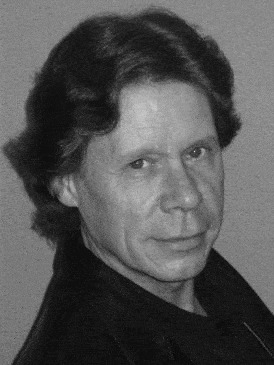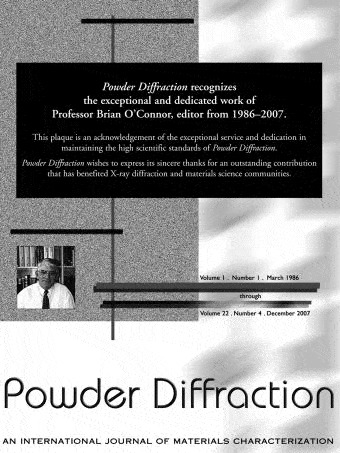
We are delighted that Ian Madsen (pictured above) of the Commonwealth Scientific and Industrial Research Organisation (CSIRO), Australia’s premier research institute, has accepted our invitation to serve as an editor starting January 2008. His involvement in X-ray analysis spans some 39 years, covering a range of fields including X-ray fluorescence and both X-ray powder and single-crystal diffraction.
He has a long-time interest in the determination of optimum data collection strategies for the analysis of powder diffraction data, and focuses on the effect of step counting time, step width, and instrumental configuration on refined structure parameters. This work culminated in the development of a novel data collection regime involving a variable counting time (VCT) strategy, which varies the counting time at each step inversely with instrumental and sample related factors. The VCT strategy therefore ensures that all diffraction peaks are collected with near constant counting statistics, with benefits in the refinement of crystal structure parameters.
He also maintains a strong interest in the application of diffraction techniques for solutions of industrial problems. Recently, he was the project leader for the development of a first-ever prototype on-line X-ray diffraction instrument for the analysis of finished Portland cement. The instrument is designed to return quantitative estimates of cement mineralogy minute-by-minute to the plant control room. The concepts embodied in this prototype are now being commercialized by project partner FCT-ACTech in Adelaide.
From 1995 to 2002, in collaboration with local and international collaborators, he was the organizer and coordinator of a round robin on quantitative phase analysis conducted under the sponsorship of the International Union of Crystallography (IUCr) Commission on Powder Diffraction (CPD). The goals of the study included documenting methods and strategies commonly used in QPA, assessing levels of accuracy, precision, and lower limits of detection, and formulating recommended procedures for QPA from diffraction data. The chairman of the CPD at the time (Paolo Scardi, University of Trento, Trento, Italy) described the contribution of the round robin to the diffraction community in the following way: “These two papers are really valuable to the diffraction community, as they clearly establish the state of the art in QPA. They also point out the current limits in QPA and are among the best supports available today for people who wish to test their own procedure and practice in QPA.”
Since 2002 Ian has been involved in studies that aim to measure the mineralogical changes taking place under conditions that emulate those found in real industrial processing plants. The goal is to obtain information about the mechanism and kinetics of reactions in situ rather than relying on ex situ measurements where the extraction process can induce changes in the sample. The challenge is to reproduce the industrial conditions (in terms of temperature, pressure, and pH) safely inside the diffraction instrument. The work initially relied on the use of laboratory based XRD instrumentation, but now includes synchrotron based X-ray diffraction. In 2008 the group will further expand their capability by using the neutron diffraction facilities at the new Open Pool Australian Lightwater (OPAL) reactor in Sydney.
In addition to his many roles at CSIRO, Ian serves the national and international diffraction community in a number of ways including serving as a member of the CPD and actively participating in the commission’s projects, and serving as a member of beamline advisory panels for the two new neutron powder diffractometers at the OPAL reactor and the powder diffraction beamline at the Australian Synchrotron in Melbourne.
I would like to thank Professor Brian O’Connor for his service as a Powder Diffraction editor for the past 20 years. Professor O’Connor served as an editor for Powder Diffraction since its inception in 1985, first as a member of the Editorial Advisory Board and then as a regional editor in 1988. He steps down as it becomes difficult to devote more attention to all his responsibilities, including honorary university duties and consultancy services in the area of radiation sciences.
In addition to his over 20 years work for Powder Diffraction, Professor O’Connor has been very active in ICDD and other scientific research activities. Most notable activities include ICDD vice chairman and member on the Board of Directors (1998–2004), president of Australian X-ray Analytical Association (AXAA) (1986–1998, 2003–2005) and chairman of the AXAA 2008 Conference, chairman of Australian Nuclear Science and Technology Organisation (ANSTO) Powder Diffraction Instrument Advisory Team for the new OPAL reactor, and member on the National Committee for Crystallography and Australian Academy of Science.
Professor O’Connor’s personal research has been underpinned by his training in crystallography. His research work has focused mainly on materials science aspects of mineral exploration and extraction, downstream processing, and environmental and occupational health studies. He has authored more than 100 peer reviewed papers, including seven in Powder Diffraction, and has supervised eight completed PhD studies, all involving powder diffraction. Professor O’Connor is an emeritus professor of applied physics at the Curtin University of Technology in Perth.
We appreciate Professor O’Connor for having done an excellent job on editing and improving the many papers submitted from around the world and for the important suggestions on improving the editorial process for Powder Diffraction. A citation plaque is presented to Dr. O’Connor to acknowledge the exceptional service and dedication in maintaining the highest standards of this journal. We wish to express our sincere thanks for an outstanding contribution that has benefited the powder diffraction and materials science communities as a whole. We wish Professor O’Connor all the best.



